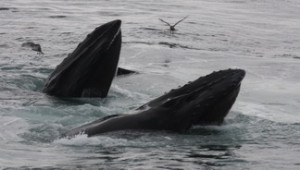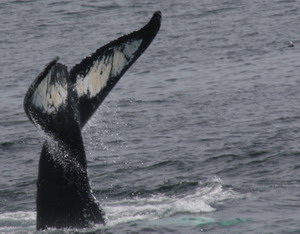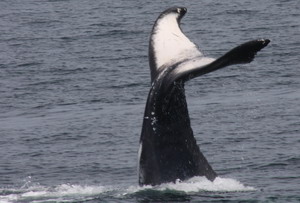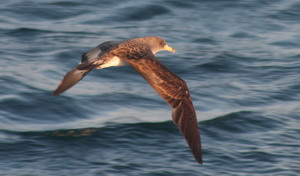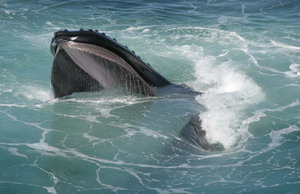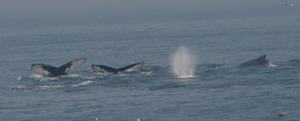Dolphin Fleet Naturalist Notebook 12 July to 18 July
On July 12 our trip started in full force as soon as we rounded Race Point Light at the northern tip of Provincetown. Race Point is the area where the waters of Cape Cod Bay meet the waters of the Atlantic Ocean. The combination of colliding water bodies, fast currents, and tidal movements make this a very dynamic area where nutrients are constantly being cycled and where a wide variety of wildlife will often gather to feed.
Today, several humpbacks gathered near Race Point to feed, frequently bursting up at the surface with their mouths wide open and full of fish. After leaving these whales and heading a few miles to the east, we soon found ourselves surrounded by 20-30 humpbacks, displaying a full spectrum of humpback whales behavior.
We had lobtailing, chin breaching, flipper slapping, and of course, more feeding!
On the afternoon trip, we continued to see both humpback and fin whales feeding off the Race, and even off of Herring Cove Beach in Provincetown. Bluefish, a favorite of sport-fisherman made the water look like it was boiling. These fish were probably feeding on the same schools of sand lance that the whales were after. Amazingly, the whales were close enough to shore so that vacationers sunbathing on the beaches of the Cape Cod National Seashore would have been able to see spouts!
On July 13, passengers on the Dolphin VI learned about humpback whale behavior straight from a mother humpback herself. Mural, a female humpback here with her calf this summer, would demonstrate a behavior, and her calf, who is about 6 months old at this point, would follow suit. Mural would lobtail, and her calf would stick its tail out of the water and smack it down. Mural would slap her flipper, the calf would roll over and slap its flipper. Mural would breach, and the calf would breach. They breached back and forth like this several times!
Mural lobtails Mural’s calf lobtails back
Today we also documented and photographed a humpback whale named Ebony. Last week, the disentanglement team from the Provincetown Center for Coastal Studies came out to Stellwagen Bank to remove a large amount of rope from her body. While there is still some rope or line coming out of her mouth, the hope is that she will free herself from the remainder of this entanglement on her own. Over 60% of humpback whales show signs of having been entangled in fishing gear at some point during their lives and researchers are currently trying to figure out how to prevent these entanglements from happening.
Ebony
While we are frequently overwhelmed by the dramatic behavior of our whales, it is important not to overlook other important animals in our ecosystem, which is why we always keep a lookout for birds. Throughout the season, we have been seeing an unusual number of Cory’s Shearwaters, normally found closer to Martha’s Vineyard at this time of year. These gull-sized birds are highly migratory and are here from the Mediterranean. The birds that are here now are either failed nesters or have already nested. We are also starting to see a several Pomerine Jaegers during our trips. See this week’s bird update for more information on the latest bird sightings.
Cory’s Shearwater
A good day for birdwatchers often is a good day for whale watchers as well, as these pelagic birds feed on the same small sand lance that these whales are after. On July 14, north of Race Point in the eastern portion of Stellwagen Bank, humpbacks including Isthmus, Thread, Rattan, Stub, and Infinity were kick feeding and lunging through large schools of fish. As these whales blew columns of bubbles in patterns of concentric circles, we could actually watch as the tiny, silvery sand lance became trapped in the center of these rings.
Also in the area we could see Stellwagen Bank National Marine Sanctuary scientists conducting research on the feeding behavior of these whales. Their project involves putting suction-cup tags on these humpbacks which document, among other things, dive depths and lengths, pitch and roll of the animal, as well as the sounds made and heard by the whales. They are trying to learn more about the feeding behaviors of these animals from both a spatial as well as acoustic perspective.
July 15 was another big day for humpback whale feeding. Rocker, Dusky, Bullet, Reflection, and Fracture were all gathered near the Southwest corner of Stellwagen Bank, feeding along the upwelling caused by the underwater ledge of the bank.
Keeping track of individual humpbacks over the years because it helps us to recognize trends in populations. We can learn about migration habits, feeding characteristics, and calving patterns by documenting multiple generations of animals. For example, Mars, seen on this date, has had 9 calves since she was first seen in 1979. Many of these calves come back to Stellwagen Bank year after year.
We can also use this information to notice changes in the population as well as the local ecosystem. If humpbacks who normally come back year after year start using other habitats, it might cause scientists to examine the environment for potentially dangerous disruptions.
Among the humpbacks, we had another, more unusual sighting – a mola mola! Mola molas, or ocean sunfish, are considered by some to be the largest type of zooplankton. Weighing in at over 600 pounds, they drift along with currents, feeding on jellyfish and other smaller types of drifting sea creatures.
On July 16, the boat headed toward the center of Stellwagen Bank, making our first stop to take a look at Vibes and her calf. So far this season, over 50 humpback whales have brought their calves back from southern latitudes to the Southern Gulf of Maine, and we are still seeing new calves all the time! This is the first week that Vibes and her calf were documented here on Stellwagen Bank.
As we left Vibes and her calf and headed north, we were momentarily stymied. We had many spouts to the north, possible feeding to the east, and constant splashing to the west. Where should we go first? We finally decided to head towards the white water, and upon arriving, we found Broomball lobtailing. Broomball is on the small side for  a humpback and is a probable juvenile. Broomball is one of the newest additions to the humbpack whale catalog of known individuals, and was just named last April.
a humpback and is a probable juvenile. Broomball is one of the newest additions to the humbpack whale catalog of known individuals, and was just named last April.
After watching Broomball kick and splash for a while, we consulted with other whale watch captains over the radio. They insisted that the southwest corner of Stellwagen Bank was the place to be for feeding whales. We had just enough time to get a look at bubble feeding humpacks, open mouth feeding and lunging through schools of prey, before we had to head back in for the day!
July 17 was the kind of day every whale watcher dreams about. Although it was steamy on land, the seas were flat calm and the feeding frenzy we had seen throughout the week had not subsided. The morning trip got spectacular views of feeding fin whales, including a rare glimpse of its belly. After lunging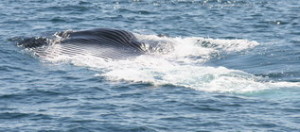 through its school of prey, a fin whale will sometimes roll over completely revealing the rorqual pleats that line its underside.
through its school of prey, a fin whale will sometimes roll over completely revealing the rorqual pleats that line its underside.
Recent studies on fin whale feeding behavior have demonstrated that they use their great speed as an advantage. Upon locating a school of fish, they will lunge towards their prey, but then abruptly pump their tail, essentially “putting on the brakes.” The powerful stop forces their mouth to open at an angle exceeding 90 degrees, their ventral pleats expand to accomodate a volume approximately the size of a school bus!
Fin whales aren’t the only animals with these ventral pleats. The humpback is another rorqual whale. These pleats were also evident as Ember, a large male, breached several times, showing off his tuxedo-like belly.

In the evening, the flat, calm water reflected the sunset, creating colors that we rarely see unless we’re lucky enough to be on the water. As the sun set in view of Herring Cove Beach, the simultaneously rising full moon was visible over Wood End Light, creating a perfect ending to a beautiful day of whale watching.
The feeding continued into July 18 with more humpbacks, including Anchor, Freckles, Ganesh, and Sirius gathering on the Southwest corner of Stellwagen Bank, the feeding hotspot over the course of the week. Gulls, terns, and three types of Shearwater, including the Cory’s, Greater, and Sooty, swooped down over bunches of feeding humpbacks hoping to grab any fish that don’t make it into the humpback’s 100-gallon capacity mouth. While it seems like this is largely an unsuccessful feeding strategy for these birds, it seems that they can’t resist the tremendous amount of food that gets pushed right up in front of them.
We often remark that conditions change so quickly around here. There are days when a morning of feeding will give way to an afternoon of rest, only to be followed by an evening trip where whales have moved to different locales all together. Rather than stay in tight-knit groups, humpback whales will associate for short periods, only to form differently-composed groups later. After a week of such rich resources and exciting behavior, we can only hope that this continues in following weeks.






